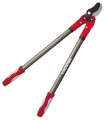The largest diameter (thickness) of a branch that the tool can handle.
The larger the maximum cut diameter, the more powerful this model, the lower the likelihood that a certain branch will be too tough for the tool. At the same time, note that to ensure high power, long handles and strong blades are needed, which accordingly affects the dimensions, weight and price. Therefore, it is worth choosing according to this parameter with a certain margin, but at the same time, this margin should not be too large.
As for specific figures, a maximum diameter
of 20 mm or less is considered relatively small, but it often turns out to be quite enough for simple work.
21 – 30 mm — the average value,
31 – 40 mm — above average, and in loppers the maximum thickness can
exceed 40 mm.
The ability
to adjust the length of the handles or the width of their disclosure on the tool, adjusting it to certain situations.
Longer handles at least allow you to reach further and achieve more force on the blade (due to the large length of the lever); shorter ones, in turn, make the tool more compact and manoeuvrable. In these moments, the meaning of this adjustment lies: in cramped conditions, the handles can be shortened, reducing the length of the tool to a minimum, and if there is enough space, lengthen in order to reduce the cutting force and at the same time increase its efficiency.
Note that in some models, in addition to the length, the distance between the handles can also be adjusted — to adjust to the personal characteristics of the user. This point should be clarified separately.
